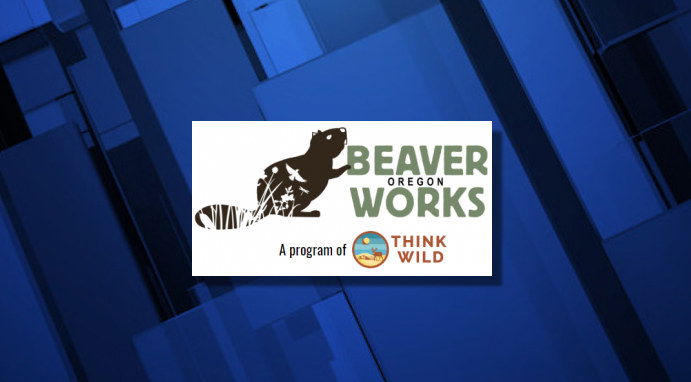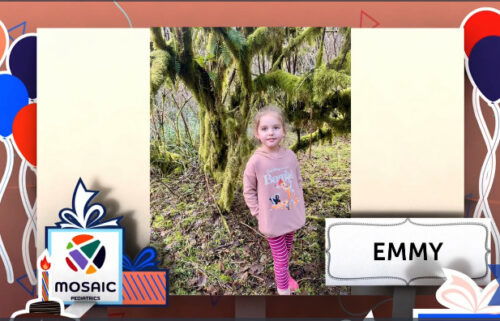Think Wild launches Beaver Response Team

BEND, Ore. (KTVZ) -- Think Wild, Central Oregon’s new wildlife hospital and conservation center, is excited to announce the launch of its “Beaver Response Team.”
The response team is an integral part of Think Wild’s program Beaver Works Oregon, which works to build awareness of beaver as a keystone species, enhance habitat and mitigate beaver conflicts.
Every spring and summer, homeowners in Central Oregon — especially those living along a river or stream — may experience fallen trees, property flooding or culvert blockages.
This is thanks to the hard work of a large, tree-gnawing, aquatic rodent — the beaver.
While tree chewing and dam building may disrupt one’s carefully landscaped yard or pose a risk to a nearby structure, these activities are actually critical to maintaining Central Oregon’s watershed health and create essential habitat for native wildlife.
The Beaver Response Team helps homeowners mitigate beaver damage through proven tools and techniques such as exclusion fencing, sand paint, flexible flow devices and culvert protective fencing.
People experiencing beaver conflicts — whether on private or public land — can call the Beaver Response Team, and within 24 hours, field technicians trained in beaver mitigation solutions will provide an initial free consultation.
Further resources and support are also available, to include on-site assessments and field implementation services, for a nominal fee on a sliding scale.
Beaver are valuable to Oregon’s high desert watersheds. Environmental economists estimate that ecosystem benefits of improved water quality, water availability, vegetation and even flood control amount to $120,000 per beaver.
Oregon native wildlife (and many endangered species, including the Oregon Spotted Frog, Redband Trout and Sage Grouse) rely on the favorable habitat conditions created by beavers.
By educating individual landowners and land stewards on these benefits and providing viable, alternative solutions to lethal removal, Think Wild hopes the program will help both humans and wildlife alike to coexist and even thrive.
To learn more, visit www.beaverworks.org or contact the Beaver Response Team (541-362-1024) for a free 30-minute phone consultation.
# # #
Beaver Works’ mission is to support beaver and native wildlife habitat on Oregon high desert landscapes in four different focus areas: Education, Support, Habitat and Policy. Beaver Works is a program of Think Wild, a 501(c)(3) nonprofit and a licensed, insured member of the National Wildlife Control Operators Association
Coincidentally, the Western Environmental Law Center issued this news release Friday regarding a recent federal decision to allow a federal agency to resume killing beavers in Oregon:
Trump administration OKs beaver killing in Oregon, despite harm to endangered salmon, steelhead
Jun 19, 2020 | News Release
Despite recognizing that restoring beaver populations is key to recovery of imperiled salmon and steelhead species, a federal agency just gave the go-ahead to keep killing beavers in Oregon.
In a long-awaited analysis, the National Marine Fisheries Service (NMFS) issued its findings on the impact on salmon and steelhead of continued killing of Oregon beavers by Wildlife Services, an arm of the U.S. Department of Agriculture.
The NMFS analysis highlighted the importance of beavers in creating excellent fish habitat and demonstrated that beavers have been reduced to only 3-10 percent of their historical populations. Despite the clear connection between beavers and healthy salmon and steelhead populations, NMFS concludes that Wildlife Services’ beaver killing will not harm twelve species of salmon and steelhead that require protection under the Endangered Species Act because their populations are so imperiled.
“NMFS acknowledges in this opinion that Pacific Northwest salmon and steelhead evolved with beaver dams and adapted to their presence, yet, in the same document turns a blind eye to a federal agency killing 400 or more beavers a year in the Beaver State,” said Andrew Hawley, an attorney with the Western Environmental Law Center. “Allowing Wildlife Services to resume business as usual, NMFS missed the opportunity to set clear guidelines on when beaver killing shouldn’t and should be allowed given beavers’ importance to the threatened and endangered fish of Oregon.”
The NMFS analysis, called a biological opinion, does require some long-overdue minimum measures to better understand how many beavers are being killed, such as accurate monitoring and timely reporting. In the future, NMFS has instructed Wildlife Services to provide information on the benefits of beavers and their dams, and the availability of non-lethal control measures to anyone who asks the agency to kill a beaver within salmon or steelhead habitat.
In its opinion, NMFS also encourages Wildlife Services to promote the use of nonlethal methods to remove or discourage beavers. These non-lethal control measures — such as flow control devices to maintain the level of beaver ponds, fencing to prevent beavers from building dams in culverts, and wrapping trees — are widely available and effective tools to reduce conflicts and allow beavers to play their essential role in aquatic ecosystems.
“This opinion is a classic mix of science and politics in the Trump era,” said Nina Bell, executive director of Northwest Environmental Advocates. “The science overwhelmingly says that beavers are essential to preserving and creating salmon habitat, yet the federal agencies conclude that continued beaver killing should proceed so long as they send reports about it. Unfortunately, there is no link between more paperwork and salmon survival.”
The NMFS opinion was spurred by a 2017 threat by environmental groups to sue Wildlife Services over its failure to analyze the effects of its beaver killing on threatened and endangered salmon and steelhead. As required by the Endangered Species Act, program managers then agreed to consult with NMFS and to stop killing beavers, river otter, muskrat, and mink in Oregon pending this opinion.
Numerous studies show that beavers benefit endangered salmon and steelhead by creating ponds that provide fish with food and habitat. Despite these well-established ecological benefits, in past years, Wildlife Services killed hundreds of beavers annually with traps, snares and firearms. In 2016 the program in Oregon killed more than 400 beavers—the official state animal.
“Beavers are ecologically important, as well as hardworking and adorable, and the federal government should stop killing them,” said Collette Adkins, a Center for Biological Diversity attorney and biologist. “I’m glad that over the last several years, our efforts saved hundreds of Oregon’s beavers. We’re going to keep fighting for them.”
ESA-listed species NMFS says killing beavers is “likely to adversely affect” but “not likely to jeopardize the continued existence” of:
Columbia River chum salmon
Middle Columbia River steelhead
Lower Columbia River coho salmon
Lower Columbia River steelhead
Lower Columbia River Chinook salmon
Upper Willamette River Chinook salmon
Upper Willamette River steelhead
Snake River spring/summer-run Chinook salmon
Snake River fall-run Chinook salmon
Snake River Basin steelhead
Oregon Coast coho salmon
Southern Oregon/Northern California Coast coho salmon
ESA-listed species NMFS and Wildlife Services say killing beavers “may affect but are not likely to adversely affect” the following species or their critical habitats:
Upper Columbia River spring-run Chinook
Upper Columbia River steelhead
Snake River sockeye salmon
Southern distinct population segment Pacific eulachon
Southern distinct population segment green sturgeon



